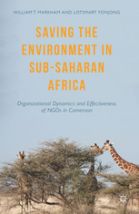Saving the Environment in Sub-Saharan Africa: Organizational Dynamics and Effectiveness of NGOs in Cameroon

Saving the Environment in Sub-Saharan Africa presents the collaborative research of William Markham (University of North Carolina at Greensboro, USA) and Lotsmart Fonjong (University of Buea, Cameroon). Together they focus on environmental nongovernmental organizations (NGOs) in sub-Saharan Africa, and draw upon their in-depth study of environmental NGOs in Cameroon to fill some existing gaps in knowledge as well as to contribute to theory development and offer recommendations for praxis. Due to the inherently practical nature of environmental NGOs, this book is geared to both inform scholars and offer practical guidance to NGOs and other development practitioners (page 9). This is reflected in both the structure and language of the book, and the way the authors isolate theoretical discussions into specific sections so that they can be accessed or avoided depending on the readers needs.
The first chapter introduces the book and clearly outlines its contents and purpose, as well as identifying the questions that drive the research. In particular, it highlights that Markham and Lotsmart’s research into environmental NGOs asks classic questions associated with the study of organizations and their role in society (page 8). Answering these questions is the goal of their book – a task they feel is imperative to accomplish before the potential contributions of specific environmental NGOs can be assessed.
To lay out the theoretical framework for Markham and Lotsmart’s research into the organizational dynamics and effectiveness of environmental NGOs in Cameroon, Chapter 2 discusses interest group theory, social movement theory, theories of civil society, and theories of organizations. It also describes political systems in sub-Saharan Africa and identifies seven topics that help to understand how African politics influences environmental NGOs (page 20). Chapter 3 details the research methods that the study in Cameroon followed, and elaborates on its three main data sources. These include information from previous research, information from original documents, and data derived from interviews with 52 leaders of environmental NGOs in Cameroon (page 40). Chapter 4 gives the reader a thorough introduction to the context of Cameroon, in terms of geography, demography and environmental problems. This is continued in Chapter 5, which presents Cameroon’s political, economic and social context, and highlights how this significantly influences the goals, strategies and activities of Cameroon’s environmental NGOs (page 61).
Chapter 6 provides a profile of the environmental NGOs studied and includes an examination of their origins, continuity, size and employees. The following four chapters then deal with key challenges facing environmental NGOs in Cameroon. In Chapter 7, money – relating to NGO budgets, funding sources, funding shortages and their effects, and dependence on foreign funds – is examined by drawing upon the study’s data. The next challenge examined is the relationships NGOs have with the Cameroonian government. Chapter 8 explores the relationships with government based upon NGOs’ needs (page 145). Continuing the focus on relationships, Chapters 9 and 10 look at Cameroonian environmental NGO relationships with local communities and with other environmental NGOs, respectively. Chapter 9 identifies previous research findings and then breaks some new ground by drawing upon the study data in Cameroon to examine the number of communities served, quality and nature of relationships with local communities, and community collaborations (page 168). Chapter 10 meanwhile explores the complex way that environmental NGOs interact with one another, and then uses the study data to examine relationships with environmental NGOs both within and outside of Cameroon. To end, Chapter 11 identifies the implications of the study findings for organizational theory, practice and policy (page 195).
Book note prepared by Hannah Keren Lee
Search the Book notes database
Our Book notes database contains details and summaries of all the publications included in Book notes since 1993 - with details on how to obtain/download.
Use the search form above, or visit the Book notes landing page for more options and latest content.
For a searchable database for papers in Environment and Urbanization, go to http://eau.sagepub.com/

